Hard Lads
as an
Important Failure
By Robert Yang. This post “spoils” what happens in my new game Hard Lads. If you care about spoilers, you should play it before reading. It takes about 5 minutes to play once, and maybe 20 minutes to play it to 100%.
Originally published June 21, 2020 on the Radiator Design Blog
In 2015, a phone video of young, muscular White British men hitting each other with a chair went viral. Why make a game about this meme now? Some might characterize my output derisively as “meme games” — which is fine — but personally, I’ve tried to avoid doing it on purpose. First, my games themselves strive to be the original meme, and not merely a fan reproduction. Second, many memes are steeped in internet gamer culture, the only circle jerk I want to avoid.
However. I think British Lads Hit Each Other With Chair is
one of those classic internet videos that merits special
attention. It does so much in a single minute, and it’s not about
video games at all. So that’s why I made Hard Lads.
At the start of the video, the men kiss briefly and instinctively, as if they’ve done it before so many times. It’s a strong and surprising hook.
Let’s assume these lads are straight. In her book “Not Gay: Sex Between Straight White Men”, Jane Ward asks, why do seemingly Straight White Men do such seemingly Gay White things? This was also a central question in my previous game The Tearoom, whose primary source, Laud Humphreys’ “Tearoom Trade”, shows how
men who have sex with men (MSM) define sex by social context rather than the sexual activity involved.
- Let the straight men kiss, I say, and let anyone access silly macho hunky gender performance. We’re not going to police their identity. Humphreys and Ward believe straight MSM when they say they aren’t closet cases in denial. These are straight men living straight lives who do Stuff with men for whatever reason.
- …but when they kiss to mock queerness, they best not miss. Ward argues that when straight White men treat kissing like a stunt or hazing ritual, it is more about asserting their straightness. The underlying joke is that LGBTQ intimacy is less real than their strong, infallible heteromasculine bond. This resulting straight male energy forms a magical force field to negate queer possibility.[note]
The real insult is that they think queer energy can be dispelled so easily! The video shows how straight mate energy is actually quite fragile. It just takes one minute to utterly destroy the lad’s masculinity on video. In the end, I argue that queer love is also the force that honors masculine vulnerability, that only we have the power to reclaim these lads.
Hard Lads casts the player as the video’s invisible camera man in first person perspective. Originally I did this for three reasons: (1) This is the most literal game concept implied by the video, which was funny to me. (2) The idea of building a detailed high resolution 3D world, then forcing the player to stare at a shitty pixelated phone screen, was funny to me. (3) I already had the hand and phone assets ready from a previous prototype.
As I developed the phone view model, I realized another crucial implication. In the game engine I use two cameras: One camera to render the 3D world background, and the other to render the handheld phone foreground, similar to how most first person shooter games render guns. Thus there is no perspective distortion on the phone’s image because the handheld phone is basically just a fancy picture frame with a hole in the middle, which makes it feel more like a seamless lens rather than a digital camera. We’re looking directly through the phone, not so much at the phone.
This phone camera gaze is what drives the lads to perform. They’re only doing this because their mates are watching them.
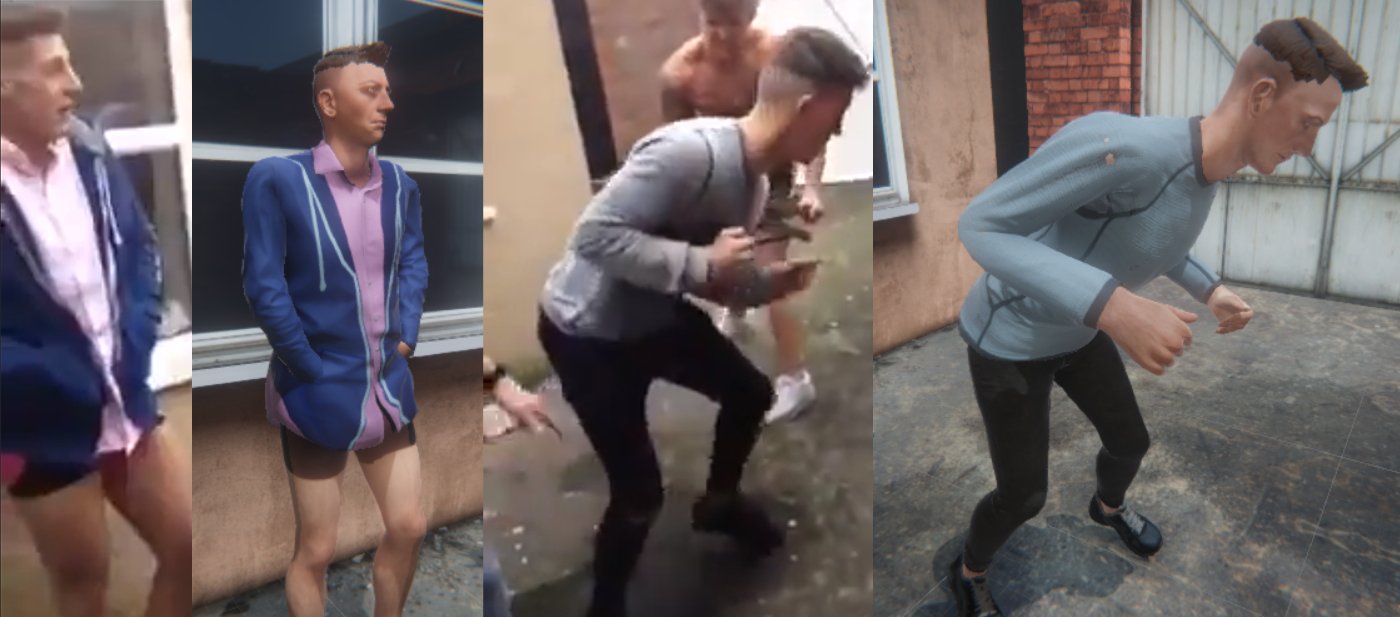
This gaze is also the guiding principle behind my in-game implementation of the video’s secondary characters: cigarette scavenger lad and pink shirt lad. They appear momentarily from out-of-frame like Slender Man, and conspicuously disappear as soon as you look away. I do this because this is the logic of the video. When pink shirt lad suddenly appears, I imagine most viewers think “Wait who the fuck is this random guy?” Well, he only exists (or not-exists) because we were (or weren’t) looking at him. As in The Tearoom, I want to make “looking” feel like a game interaction with its own rules and power.
The video begins with the main lad performing gestures of edgy heteromasculinity. He mutters “aw fuck it,” chugs his indeterminate alcoholic beverage (wine? cider?) before smashing the bottle on the ground, and then takes one last drag from his cigarette before wantonly discarding the perfectly good roach.
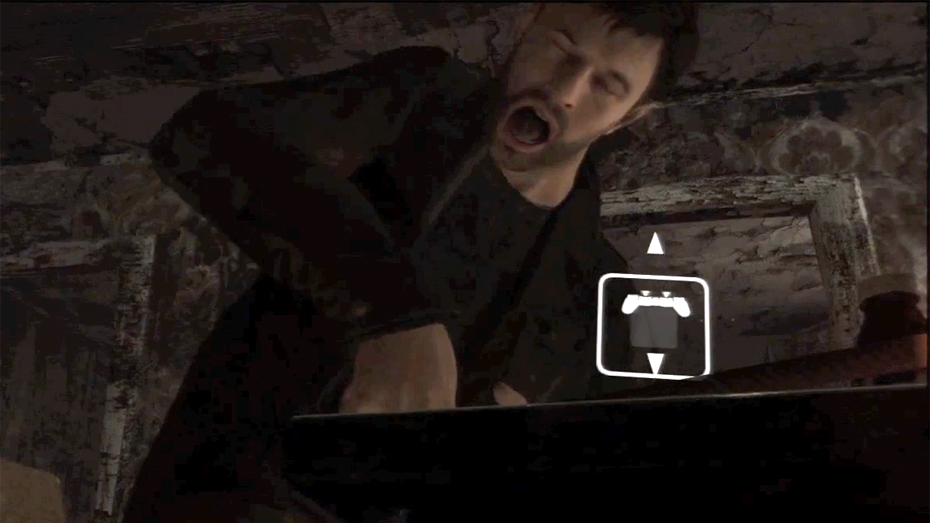
Like a lot of adolescent masculinity, there’s something exaggerated and try-hard about all this. In recreating these performances, I’m inspired by the fundamental awkwardness of early Quantic Dream games like Fahrenheit (Indigo Prophecy in the US) and Heavy Rain. These games use mimetic analog inputs, like holding the thumbstick upwards to open a door. But most of these interactions aren’t actually analog, they’re binary. The most meaningful states are 0% and 100%, success or failure. For any slightly mischievous or curious player, this encourages dwelling in that strange 50% area, imparting an uncanny hesitation to even the most trivial of gestures. (The rapper Soulja Boy famously dwelled in Braid’s halting in-between space.)
Quantic Dream’s auteur figurehead David Cage has long offered an unconvincing design rationale for this commitment to mimed pseudo-analog input. Supposedly it offers a more realistic player performance in service of greater cinematic immersion. Imagine Heavy Rain’s input tutorial, where you slowly rotate the thumbstick to set plates on a dinner table. Is that realistic, immersive, or even intuitive? To me, it mostly felt silly, awkward, and unnecessary… the perfect input method for performing masculinity.
Hard Lads recreates the main lad’s exaggerated pre-game gestures like smoking a cigarette, swigging a bottle, and manly kissing. Each of these actions can be endlessly paused, repeated, interrupted, and failed. Smoking for too long can cause a coughing fit, liquor can be spilled wastefully onto the ground, and a manly fist bump of a kiss can turn into a hot makeout session.
The nature of this failure is complicated and interesting. After all, the video isn’t really about how this lad gets hurt, it’s about how he gets hurt in all the wrong ways, like some sort of cartoon coyote endlessly thwarted by a roadrunner. He wants to project so much power, but he’s also just so powerless.
Instead of hitting him squarely on the back, the chair lad sort of spanks him, prompting confused silence instead of cathartic manly cheering. “What are you doing? [Hit him] over his back!” gasps an onlooker. Chair lad fails to heed the advice, and a second awkward chair spank sends the hurt lad to the ground. The chair lad doesn’t even understand how to hit someone with a chair, and the hurt lad can’t even endure a couple suboptimal spanks.
Practically everyone in this video has failed this public test of masculinity. Which is why I also made this game’s core chair interactions feel silly, too.
When in chair mode, horizontal mouse input corresponds to striking power, while vertical mouse input lets you switch altitude between spanking him on the butt or overhead slamming him on the back. But as with the drinking / smoking / kissing modes, the chair mode is rife with potential for expressive mischief and failure. The chair itself is a ragdoll — a virtual body with floppy physics simulation — that barely sits in the batter’s hands, and there’s an incredible temptation for players to tenderly caress the lad’s ass with the chair instead of smacking it. I also tuned the hurt lad’s ragdoll to bounce wildly on a spring, so he ends up feeling more like a wacky waving inflatable arm flailing tube man.
(My in-game damage model is straightforward: The main lad starts with 20 health, and each strike inflicts damage based on chair velocity, usually 5-15 damage. Kissing beforehand heals 5 health per smooch / 5 health per second of makeout time, up to 200% overheal.)
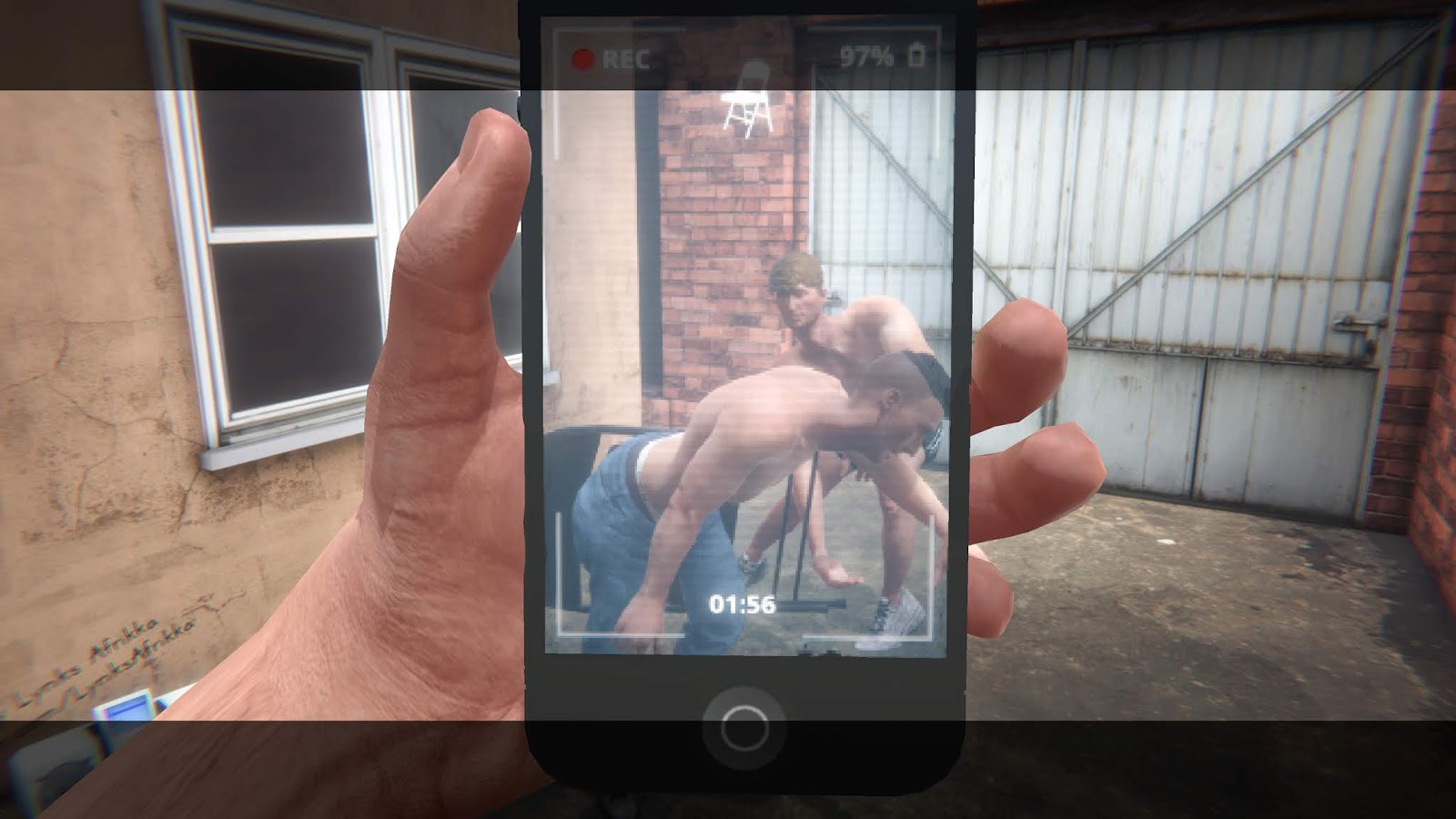
I think anti-realism designers overlook possibilities for realism in game aesthetics. Hard Lads is, perhaps, neorealist. The characters were generated from Mixamo Fuse, the camera doesn’t cut to the action, and it endeavors to maintain social realism with documentary framing.
Brendan Keogh once wrote that my characters “are so perfectly imperfect as to fall square into the uncanny valley,” and Hard Lads continues this descent into uncanny queer embodiment.
For this game I dive deeper into fumblecore, an indie game genre involving humorously inefficient and cumbersome player embodiment. Each round, the hurt lad is barely keeping it together, flailing in a very unmanly way in reaction to the slightest disturbance.
I used ragdoll physics before in my spanking game Hurt Me Plenty, but Hard Lads required a lotmore ragdoll integration with animation. Most of my development time involved building a new system to smoothly transition the lad from a fallen ragdoll to a canned mocap sequence. I kept hitting difficult game-breaking edge cases where, for instance, the physics engine would fling the lad onto the roof of a nearby house, leaving him no way of walking back.
There’s two different game programming strategies here. Prevention prevents the game from breaking at all, while repair and maintenance assumes the game will break all the time. Prevention might seem more stable at first, but it’s actually very brittle because it requires flawlessness. Repair covers more edge cases because it assumes everything is broken all the time. It’s a big change to my coding style, but I believe a reparative approach provides the best of all worlds. Unique malfunctions make the player’s performance feel special and emergent, while not being so serious as to permanently break game progress.
Which brings me to my most favorite game-breaking failure in history.
At ECW Hardcore Heaven 1994, a pro wrestler asked for a chair to smash on a fellow performer. Fans proceeded to give him many chairs, literally hundreds thrown onto the stage. This avalanche derailed the entire match. The staff begged the audience to stop, but the chairs just kept flying. It was a massive surreal breakdown in the laws of pro wrestling events. Among many queer moments in pro wrestling, this ranks among the queerest.
As a nod to this incident, Hard Lads recreates this moment at the end of every round. Once the lad collapses from too much pain, the game drops additional chairs down from the sky, starting with only 1 chair on the 2nd round, and accumulating 69 chairs in the final 7th round.
Conceptually, the allusion to pro wrestling culture is exactly what these lads are trying to perform. This connection to wrestling is also why I swapped out the video’s weird patio chair for a proper metal folding chair. In terms of formal game design, the chair rain offers a useful ramp for wordlessly conveying game progression. Hopefully players get the sense that something is escalating out of their control. I never explain how this chair rain happens, it just suddenly comes out of nowhere, a bit like the surreal rain at the end of the film Magnolia (spoiler). You could easily interpret these chairs as societal pressure from an unseen audience, or as a divine desire to hit you when you’re down. It echoes the cosmic irony of the gods thwarting every second of the lad’s life.
The rain of chairs is also a succinct way to show some sympathy, because when one lad gets hit by a chair, we all get buried in chairs. It’s about solidarity. But with who?
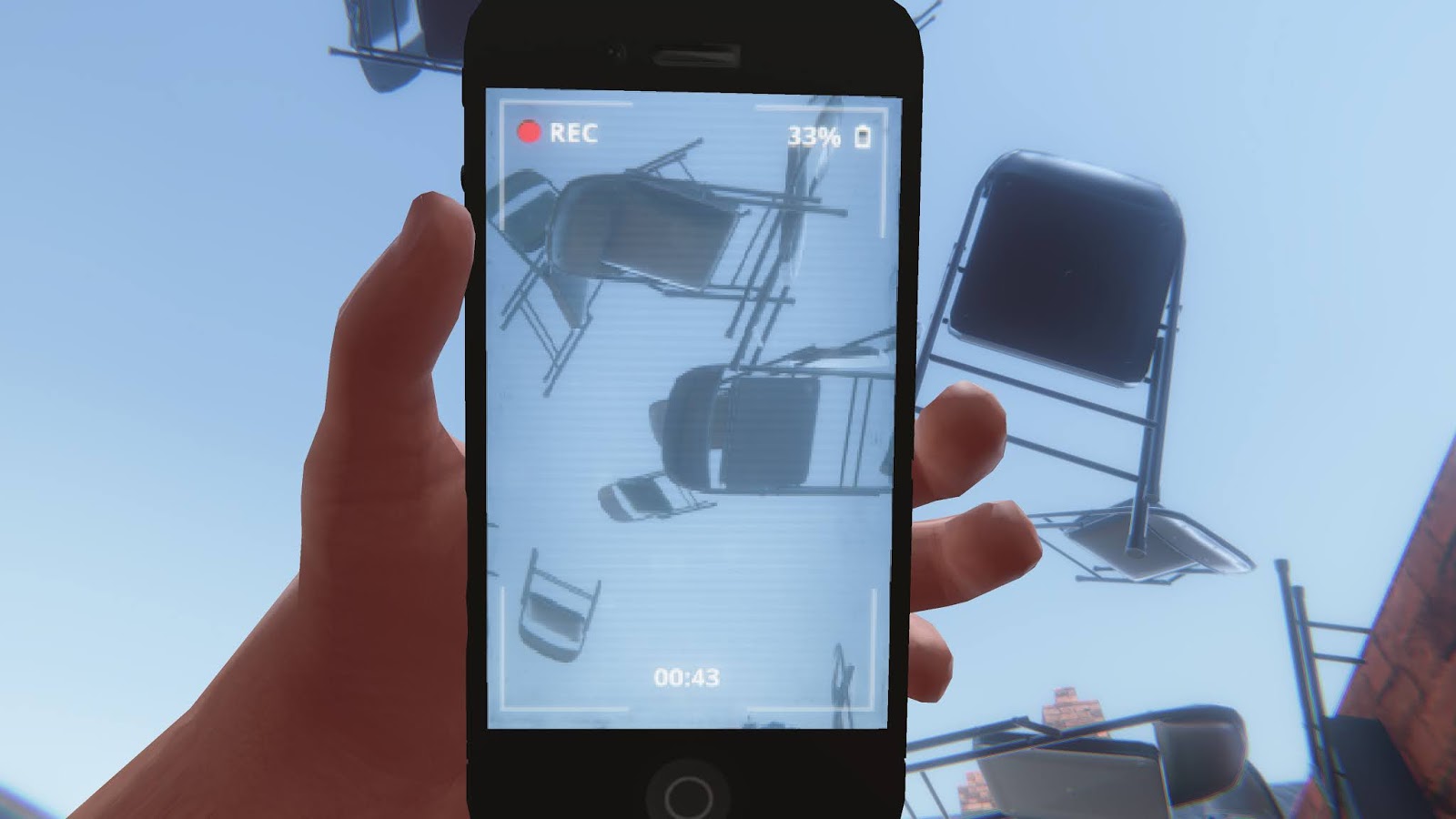
Who are these lads? From my American millennial perspective, I thought they were just some bored slacker-jocks challenging their own bodies in the vein of Jackass, except with delightful British accents that sometimes I cannot comprehend. While Jackass was maybe a bit gayer than we credited at the time, these lads are operating with clear straight mate energy.
The game’s lead musical track, “Str8 Acting” by Lynks Afrikka, parodies this tension between the straight and LGBTQ community. In the song, Lynks Afrikka chants “HOT STR8 BOYS” as a sarcastic objectification, before going on to drag said hot straight boys for their insolence. The name Lynks Afrikka parodies the deodorant brand Lynx Africa (Axe in the US), also known as the embarrassing odor of adolescent locker room masculinity, and these lads are the target demographic.
But many viewers, especially UK audiences, perceive deeper social class markers here.
The lads’ shaved haircuts, fitted fashion, muscled bodies, exposed underwear, Tyneside flats, and Northern accents, signify a specific working class identity from North East England. In the 2000s these lads might’ve been called chavs, and in the 2010s they would’ve evoked the US reality TV series Jersey Shore or its British off-shoot Geordie Shore, and TV critics noted the clear social class implications.

When talking about White working class people, there are at least two traps here. The conservative trap is to “defend” a “White working-class heritage” racist dog whistle that pushes White nationalism. Meanwhile the centrist liberal trap is to embrace classism and laugh at them for wearing the wrong clothes, drinking the wrong drinks, and living in the wrong houses. Let’s avoid both of these traps.
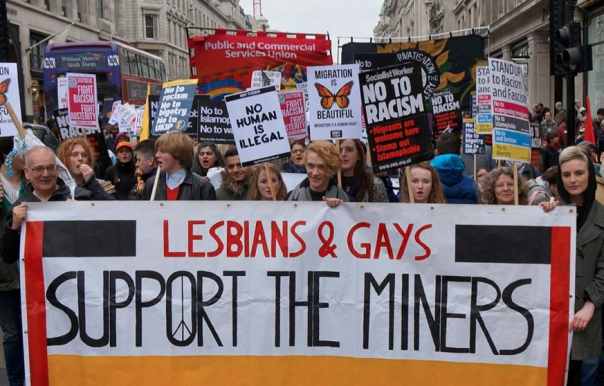
The purpose of those traps is to hide a third way: an intersectional history of solidarity, especially in the UK. In 1984, Lesbians and Gays Support the Miners (LGSM) supported mineworker unions against Thatcher during the national strike, and in turn, miners supported gay rights movements and pushed against the 1988 anti-gay law, Section 28. This was a political alliance forged long ago by our elders, proof that we can all organize together.
So in Hard Lads, I wish to honor the spirit of this ancient covenant, and err on the side of solidarity. As an outsider to the UK, I’m trying to learn about the social forces that shaped these lads, and how whiteness, class, and sexuality / gender intersect outside of the US. And I’m learning a lot! Like I didn’t even understand how to build the lads’ terraced housing at first, until someone on Twitter generously critiqued my inaccurate construction.
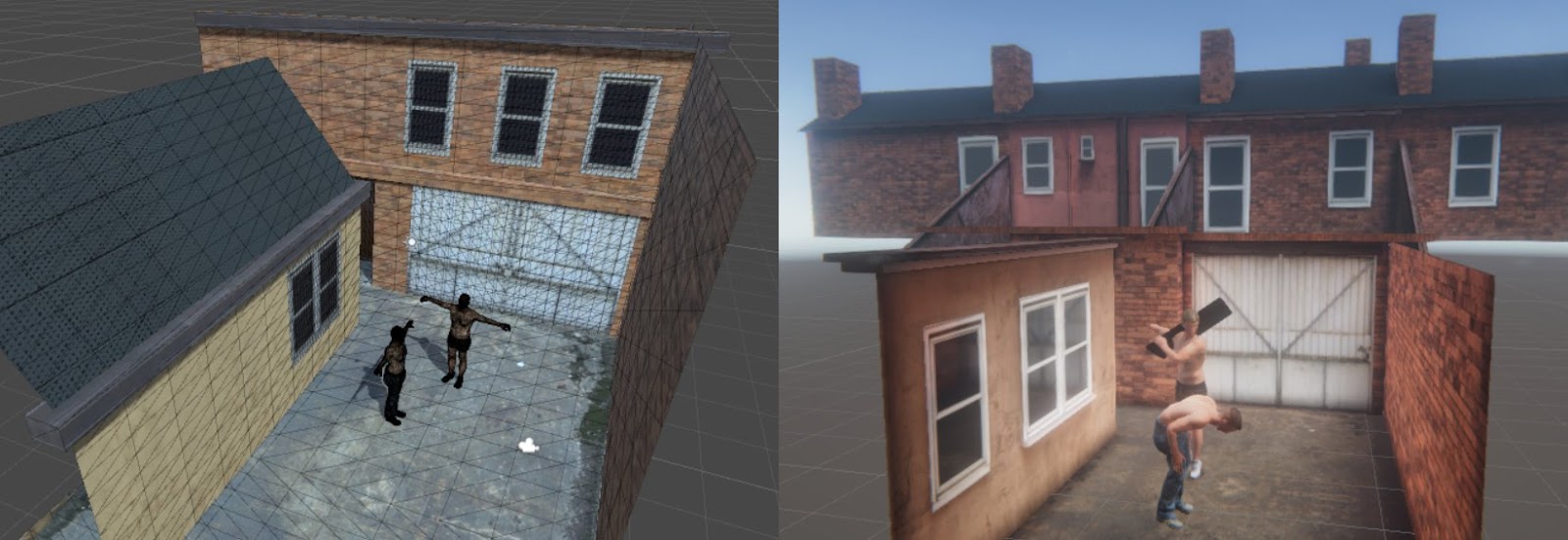
This research and sympathy are important here, because that work is about love — and the video ends with love.
The chair lad holds his wounded friend in his arms. “I’m not doin’ that again, I’m not doin’ that again,” says the chair lad. “That’s ridiculous. That’s ridiculous. That’s ridiculous… That’s ridiculous.” It’s a weepy sentimental promise not to hurt someone again, full of regret and pain, an extremely tender gesture, even more intimate than a kiss. THIS IS AFTERCARE! Yes it is a failure to be an invincible toxic manly man, which is also the failure to be cruel and uncaring. As far as failures go, this is a good failure. It’s OK to feel hurt and show vulnerability, and traditional macho masculinity allows little space for this.
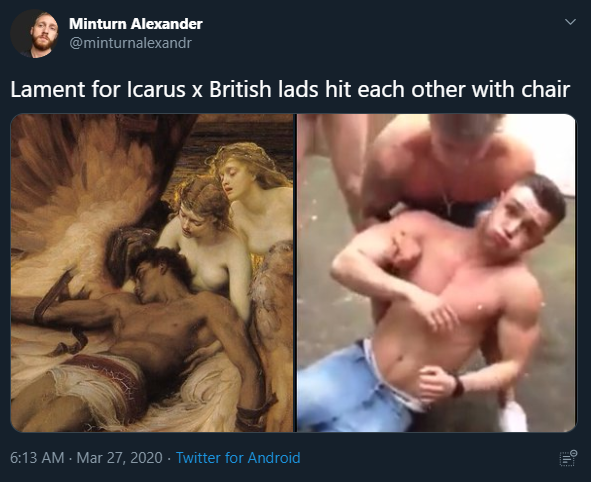
This loving pose has prompted humorous comparisons to the painting “Lament For Icarus” by late Victorian painter Herbert James Draper. Like all good jokes, there’s actually a lot of heart and truth here. The painting is quiet, somber, and dignified. It depicts the sea nymphs tending to this fallen angel, this sweet prince. Behold the soft lad cradling his fallen bosom buddy!
Unfortunately, conveying non-creepy authentic human tenderness via realistic 3D video game bodies is one of the most difficult problems in games, and ran counter to the uncanny fumblecore feel I detailed earlier. The resigned face, intimacy, humanity — I’m afraid it’s beyond the scope of my skills and resources. (While I’m confessing weaknesses, I’m a perennial fan of the “cheeky Nandos” meme, and my game’s lack of vocal lad banter worries me. But I didn’t want to upstage streamers.)
Sometimes you have to know your own limits, like Icarus. So instead I pursued a different approach while still attempting to convey some sense of love
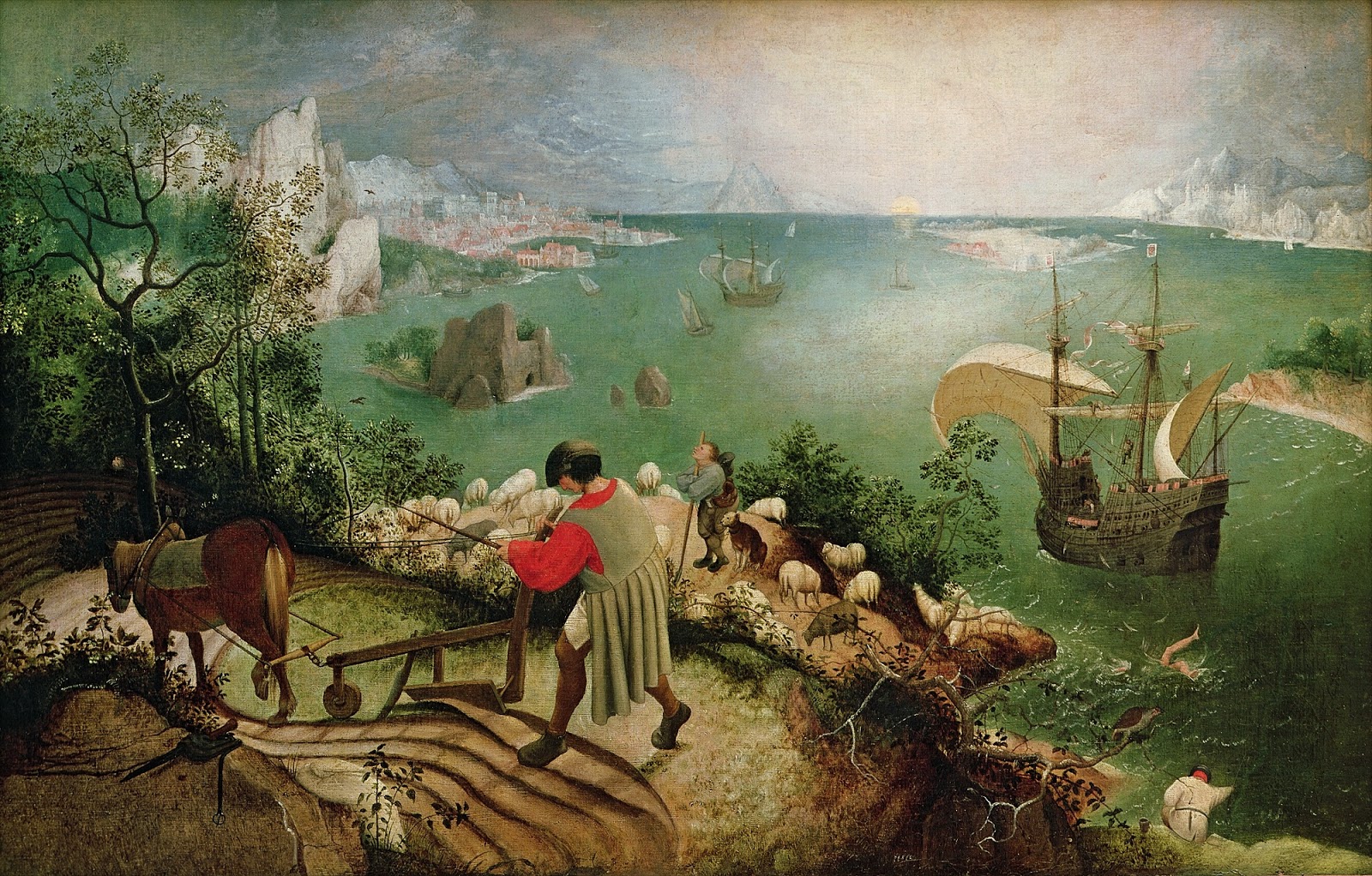
“Landscape with the Fall of Icarus” by Dutch renaissance painter Bruegel (or some other painter, who cares) emphasizes the humiliation of Icarus’ failed ambition. Viewers familiar with the myth will first look for Icarus in the sky — only to eventually locate Icarus awkwardly drowning in the ocean near the bottom-right corner. No one in the painting gives a shit about Icarus. Not only was Icarus foolish, but no one was even recording him on video! Gay poet W. H. Auden famously saw this painting in a museum and felt moved to drag / lament Icarus:
… In Breughel’s Icarus, for instance: how everything turns away
Quite leisurely from the disaster; the ploughman may
Have heard the splash, the forsaken cry,
But for him it was not an important failure; the sun shone
As it had to on the white legs disappearing into the green
Water, and the expensive delicate ship that must have seen
Something amazing, a boy falling out of the sky,
Had somewhere to get to and sailed calmly on.
– W. H. Auden, “Musée des Beaux Arts”
“But for him it was not an important failure,” claims Auden.
But it is important! In queer culture, we have a special word for important failure: “camp.” Success is for straight people, spectacular flaming trainwrecks are for the rest of us. So we don’t hate the lad for trying so hard, and in fact, we remember and love him even more for trying hard and failing. Imagine if he had successfully endured several competent swings from the chair… well, then we wouldn’t even be talking about the video, because it would be so boring!
“In naïve, or pure, Camp, the essential element is seriousness, a seriousness that fails. Of course, not all seriousness that fails can be redeemed as Camp. Only that which has the proper mixture of the exaggerated, the fantastic, the passionate, and the naïve…
[…] Camp taste is, above all, a mode of enjoyment, of appreciation – not judgment. Camp is generous. It wants to enjoy [… and] it doesn’t sneer at someone who succeeds in being seriously dramatic. What it does is to find the success in certain passionate failures.
[…] Camp taste is a kind of love, love for human nature. It relishes, rather than judges [… and] identifies with what it is enjoying. People who share this sensibility are not laughing at the thing they label as ‘a camp,’ they’re enjoying it. Camp is a tender feeling.”
— Susan Sontag, Notes on Camp
Following this tradition of camp, the ending sequence for Hard Lads began as a failure in my code. I was trying to apply physics forces to keep the ragdoll upright, but instead it levitated the hurt lad off the ground.

I watched him steadily rise into the air, as if transcending this mortal plane of pain and suffering and chairs. It was beautiful to watch his worn-out body rise above the rooftops and into the endless sky. Icarus was finally achieving his dream. While it wasn’t two shirtless hunks holding each other, there was still a sense of gentleness here.
Hard Lads’ ending sequence tries to embody this sentimental campy love. After the main lad collapses for the 7th time, he gets buried in 69 chairs, and lays there on the ground, longer than usual.
All is still. This time he’s really really hurt.
He’s not getting up. Something’s wrong. We have to do something!
That’s when chair lad bosom buddy launches into a rousing rendition of “Truly Madly Deeply”, by Australian pop sensation Savage Garden:
I’ll be your dream, I’ll be your wish
I’ll be your fantasy
I’ll be your hope, I’ll be your love
Be everything that you need
I’ll love you more with every breath
Truly, madly, deeply do
I will be strong, I will be faithful
‘Cause I’m counting on…
A new beginning,
A reason for living,
A deeper meaning, yeah.
I wanna stand with you on a mountain
I wanna bathe with you in the sea
I wanna lay like this forever
Until the sky falls down on me
Well, kind of. I didn’t use the actual Savage Garden track. Instead I ripped the audio from a viral video of a lad chorus singing a surprisingly good cover — which turned out to be an ad for athletic apparel… but I feel like my fair use / appropriation is warranted here. Just pretend I didn’t tell you that it came from an ad, and imagine it’s just a completely natural authentic recording of lads singing pop songs down at the pub.
In the game, this campy romantic gesture prompts a crowd of men to take to the rooftops, serenading their fallen mate. Their collective energy magically raises the lad out from the wreckage and levitates him to the heavens. As the fallen lad flies up into the sky, I randomly oscillate the physics forces applied to his dangling legs, which make him spin around in a dramatic fashion. I wanted his body to perform a surreal uncanny dance that looked like falling upwards in reverse. It’s the beauty of successful failure celebrated by the community.
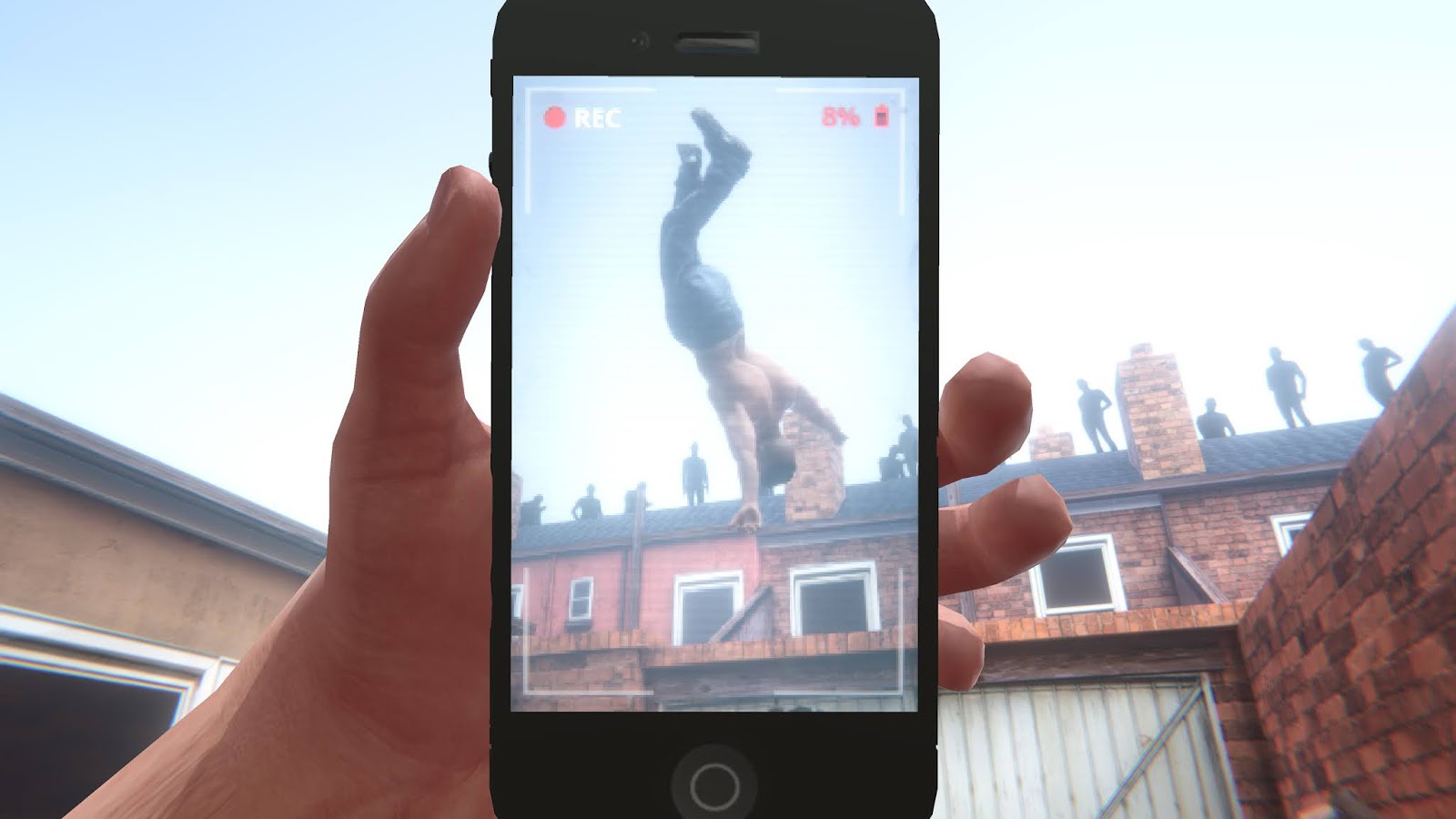
High above the rooftops, just as the lads’ final chorus swells triumphantly, there’s a randomized 50% chance for him to suddenly plummet to the ground like Icarus. I thought the morbid humor would feel appropriately British; Even with the magic of love, these lads are still merely men, God giveth and God taketh away, and so on.
For each completed playthrough, the player also earns various works of art depicting Icarus, which can in-turn unlock bonus features like a golden ratio camera overlay, classy black and white filter, or even wings. These are optional extras to reward particularly engaged players and to provide some context for repeated plays in a public exhibition setting. (It’s also funny to me to provide access to free public domain art as a game achievement.)
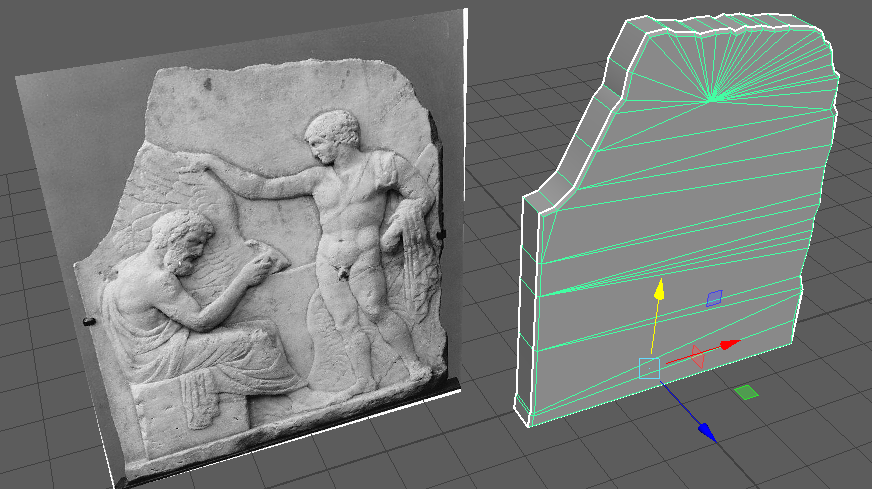
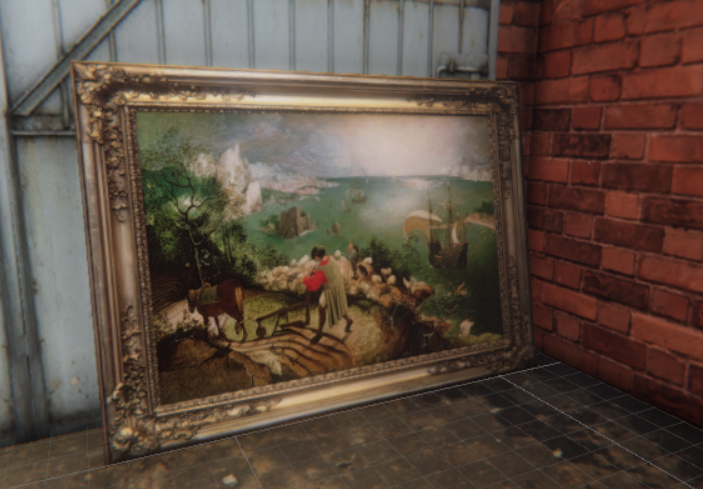
This use of art trophies is also my way of acknowledging the original tweet that prompted me to make this game: a queer joke about how the video should have its own room at the Masculinity exhibition at the Barbican. By surrounding these lads with virtual paintings and artifacts comparing them to Icarus, I concur. This video belongs in a museum.
To commemorate the player’s 7th, final playthrough and 100% game completion, I disable all game systems and replay the original video framed inside the virtual in-game phone. This scene brings a surprisingly haunting documentary feel. Most players will try to recreate the hand movements to match the video, but it quickly becomes a futile exercise. All of the game’s inadequacies and inaccuracies as a reproduction come to the fore.
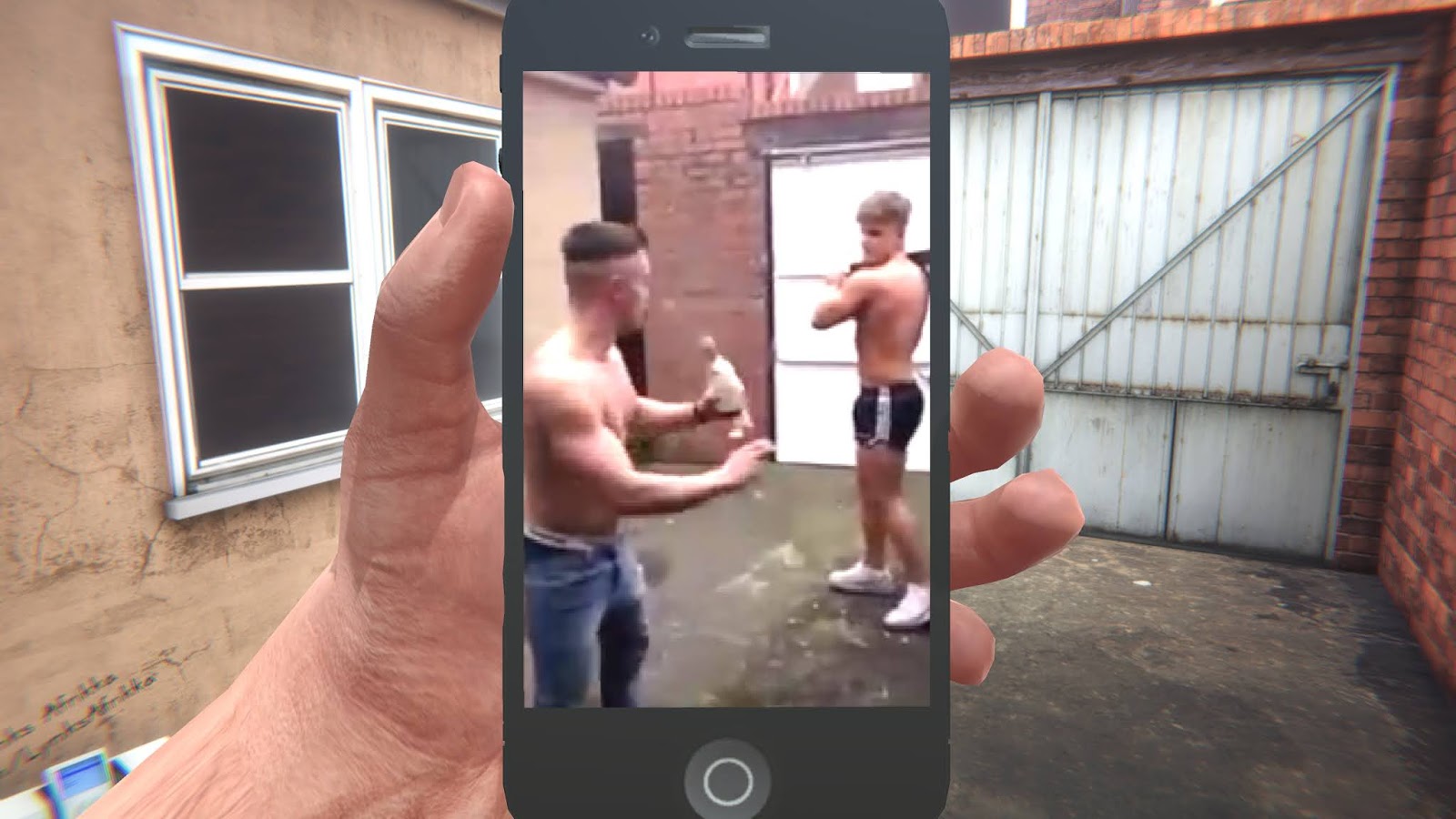
We have no choice but to appreciate the video and the game for what they are. This is the simple love one might reserve for a succinct capture of early 21st century himbo masculinity, a brilliant tragicomedy in three 20-second acts… an important failure. In honor of all the HOT STR8 BOYS who aren’t hard straight lads. Truly madly deeply softly, with tenderness, pain, and camp.
Love is why I made Hard Lads. Like many people around the world, I really love this video. I’ve watched it hundreds of times, paused countless freeze frames to examine the most trivial of details, and at this point I’ve written thousands upon thousands of words about it. It has problems, it has beauty, it’s a complex piece of culture that merits our attention.
If love is a form of magic, then I am a magical sea nymph recovering Icarus from the boy-blue ocean. I perform this spell in the centuries-old tradition of queering — as LGBTQ+ people have queered countless things before, like jockstraps, the Badabook, or the Chinese word for “comrade.” Open-ass athletics, psychological horror, and solidarity already sounds like a fantastic queer masculinity to me.
May this humble game serve as official notice to the entire world: I hereby declare British Lads Hit Each Other With Chair to be Gay Culture, the shared communal legacy of LGBTQ+ people everywhere.
Welcome home, lads.
Robert Yang makes surprisingly popular games about gay culture and intimacy — he is most known for his historical bathroom sex simulator The Tearoom and his male shower simulator Rinse and Repeat, and his gay sex triptych Radiator 2 has over 150,000 users on Steam. He is currently an Assistant Arts Professor at NYU Game Center, and he has given talks at GDC, IndieCade, and Queerness and Games Conference. He holds a BA in English Literature from UC Berkeley, and an MFA in Design and Technology from Parsons School for Design. https://debacle.us/
NOTE: Update, July 16, 2020. Michael Thomsen’s lovely review for Art in America argued a 2010 study found 9 of 10 UK university men kissed as a greeting. I think this is a bit misleading:
1) If you actually read the study (I kiss them because I love them: The emergence of heterosexual men kissing in British institutes of education) it never claims kissing is just a simple lad greeting, and in fact the word “greet / greeting” appears only once in the paper. (pg. 422: “Thus, a kiss on the lips has not been part of the historical repertoire of greetings or demonstrations of affection among men for centuries in Britain”)
2) The study samples middle class university lads in the Midlands / Southwest England, not working class Northern lads who likely have a different understanding of kissing. (pg 426: “Sam suggested that much of the reason there was so much more kissing at the university was because of the liberal environment: “I never kiss any of my friends back home,” he said. “And I can’t imagine it going down too well.” When asked about how his friends showed him affection back home, he said, “Punching and rubbing their knuckles into my head.””)
3) Even if lad-on-lad kissing were a casual norm across the UK, I question whether it’d lead to less homophobia in society. Straight Men Being More Interesting doesn’t liberate gay people. Don’t enrich straightness and call it allyship!
4) … Also, the study agrees with me and supports my claims. (pg 426: “A brief kiss, for the majority of these British men, is now a heterosexual symbol of homophilic intimacy.”)







